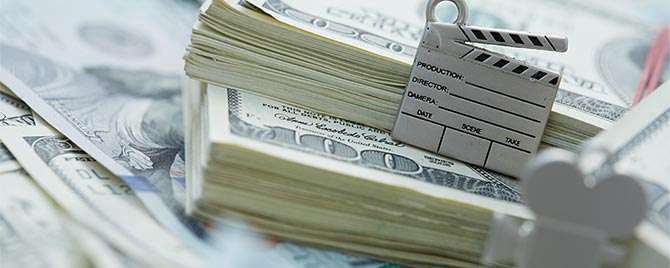Movie plots often circulate around money. Characters fight for it, die for it, steal it, counterfeit it, burn it—you name it. Using United States currency on camera is perfectly legal. In fact, Federal Reserve notes regularly appear on screen, which makes things easier for the United States Secret Service (USSS) tasked with fighting counterfeiting. But for studios, working with real cash is not always the easiest option.
Being just a few miles from Hollywood, the Los Angeles Branch of the Federal Reserve Bank of San Francisco often welcomes TV and film producers and actors. At times, San Francisco Fed employees go on set.
Jim LeVoir, our vice president of cash services in San Francisco, Los Angeles, and Phoenix, recalls working on Beautiful Day, a U.S. Treasury public service commercial.
“In 2003, I had the pleasure of project managing the release of the new series $20 note,” says LaVoir. “We worked closely with the U.S. Treasury and their public relations consultant on several events to raise public awareness of the new notes, including the commercial. I spent a few days on location at the Sony Studios lot. My job was to control a strap (a package of 100 notes) of new, as yet unreleased $20 bills. After each take, we’d substitute notes from the strap to ensure they looked crisp on film. I handed them directly to the actor and maintained a line of sight at all times.”
Now imagine productions of a much larger scale. For example, when the Joker slides down a mountain of cash and sets it on fire in Batman: The Dark Knight.
While using real currency is an option, the Joker scene is a good example of why prop masters and set decorators wouldn’t always do it. First, the scene involved millions of dollars. It would be a huge liability to have so much cash on set. Second, the scene involved burning currency, which is illegal under U.S. code and punishable by a fine or imprisonment. So, there would need to be some post-production movie magic and proof that no Federal Reserve notes were harmed during the making of the film.
What’s the prop master to do? Unless they can get away with fake straps, where only the first and the last bills are real, and the rest of the strap is filled blank notes, or “fillers,” it gets tricky. Oftentimes, they’ll turn to prop houses for a wealth of movie money, or prop money. To distinguish it from legitimate currency, prop money is marked with the words, “Motion Picture Use Only” or “Copy” and must follow specific rules.
The Counterfeit Detection Act of 1992 made illegal any replication and use of replicated currency for commercial reasons. Color reproductions can be made and displayed as long as the illustration is one-sided and 75 percent smaller or 150 percent larger than the original note. All reproductions and materials used to create them, such as plates, negatives, and digital files, must be destroyed after final use. Fakes that don’t adhere to these rules are illegal.
Despite tight regulation, prop money poses a big challenge for the U.S. Secret Service (USSS), estimating that more than $2 million of prop money has been passed into circulation since the early 2000s. Unfortunately, many prop notes are carried off of sets by extras and bystanders.
Although manufacturers promise that their notes will not pass for real currency, the look and feel of prop notes can be hard to distinguish from the real thing. When the likeness gets too close, the prop companies and studios can expect a cease and desist letter or visit from the Secret Service, like when props from Rush Hour 2 entered the local economy.
Sometimes it’s best to stick with fillers.
You may also like to read:
The views expressed here do not necessarily reflect the views of the management of the Federal Reserve Bank of San Francisco or of the Board of Governors of the Federal Reserve System.
